Make sure to cut foods into tiny pieces to avoid choking. Choose soft foods that can be mashed or dissolved easily in your baby's mouth. Avoid hard foods like seeds or nuts and heavy, sticky foods like marshmallows.
Introducing Solids: When, What, and How to Get Started
By: Dr. Maria Cerino - May 20, 2024 - 16 Minute Read
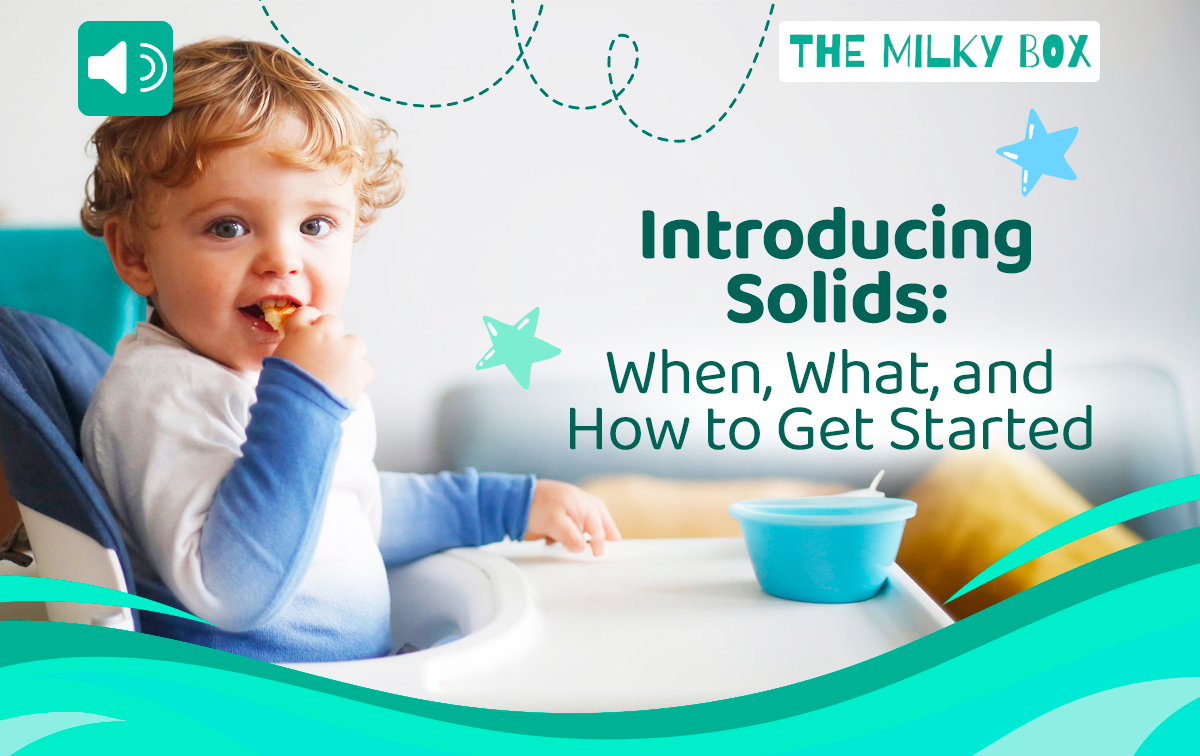
Introducing solids to your baby marks one of the biggest milestones in their development. It’s as big as taking their first steps or saying their first words.
For many parents, it also represents a stressful moment, as the information on appropriate solid introduction is endless. The choices abound, from baby-led weaning to mushy foods and ready-to-eat baby food at the supermarket.
In today’s article, we will cover everything you need to know in this beautiful new stage so you can easily get started.
Table of Contents:
1. When do Babies Start Eating Solid Foods?
2. How Do I Know When My Baby Is Ready to Start Eating Solid Foods?
3. What Changes Can I Expect After My Baby Starts Solids?
4. Does My Baby Need Water?
5. Amount of Daily Human Milk or Formula
7. Feeding Schedule for Baby's First Food
8. How to Start Introducing Solid Foods
9. Baby's First Foods by Age Food Chart
10. What Are The Signs of a Food Allergy in Babies to Look Out For?
11. In Conclusion
12. Frequently Asked Questions
When do Babies Start Eating Solid Foods?
For the first four to six months of their lives, babies exclusively need formula or breast milk. This time is sacred as their gastrointestinal tract matures in full. Infants also need to develop specific skills, such as neck and head control and swallowing control.
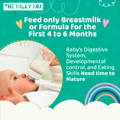
How Do I Know When My Baby Is Ready to Start Eating Solid Foods?
After the six-month mark, most infants are okay to start on solids, but there are certain clues you need to look for when the right time comes:
● Your baby should be able to hold their head up without any support when propped up.
● Your baby should not trust their tongue out when food is in their mouth. This is a typical early reflex, and you can check it at home by gently offering a tiny bit of food thinned out with formula or breast milk in a baby spoon or your clean finger.
If they keep pushing the food out multiple times, their tongue thrust reflex is still kicking in, and they’re not ready yet.
● Your baby should be able to open their mouth wide; you can see it when they mouth toys.
● Your baby should start to show interest in food by getting closer to your food and mouthing at it.
If your baby has mastered all the skills mentioned above, you're good to go and can start exploring the world of solid foods.
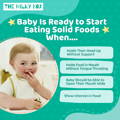
What Changes Can I Expect After My Baby Starts Solids?
As a good rule of thumb, your baby will stop consuming as much breastmilk or baby formula once they get the hang of solids. You'll notice their stools becoming firmer and changing in color. Due to the increased sugars and fats, they'll also have a more pungent odor.
This is perfectly normal, especially during the adaptation phase. Their digestive system is still not fully mature, and you’ll notice some remains of food in it, too, such as pea or corn hulls and tomato peels.
During this time, you must be on the lookout for irritation. If the stools start to be abnormally loose, watery, or full of mucus, you must consult your medical provider to find the reason.
Does My Baby Need Water?
Breast milk or formula is enough for hydration during the first six months of life. If your baby isn’t eating solids, they don’t need extra liquids in their diet. After the six-month mark, you can start offering sips of cooled, filtered, and boiled water in a baby-safe cup during mealtimes and throughout the day.
This helps them get the hang of drinking from a cup, but remember, they still mainly need breastmilk or formula at this stage. The recommended amount of water for a child who is starting solids is between 2-4 ounces of water in a twenty-four-hour period.
By the time they're 12 months old, you can offer them fresh tap water without the need to boil it. After their first birthday, The CHOC Children’s Hospital recommends that a 1-year-old gets approximately one 8-ounce cup of water every day.
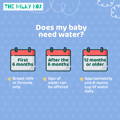
Amount of Daily Human Milk or Formula
As per the Children’s Hospital of Philadelphia (CHOP), when solids are introduced, typically around 4 to 6 months, a baby's milk intake decreases from about 30 to 42 ounces per day to approximately 28 to 32 ounces per day.
The adjustment is personalized to each child, and it widely varies on how solids are introduced, the types of solids introduced, and their frequency of consumption. Their milk consumption will gradually slow down.
By the time your child is 12 months old, their milk intake will reduce, ideally to a maximum of 16 ounces per day. It’s a slow process, so don’t worry about hitting a specific quantity until your little one is ready to move on.
How Do I Feed My Baby?
Feeding your baby is a process that must be started slowly. It requires a lot of patience, but in the end, your infant will get the hang of it: as humans, eating is instinctual. Solid foods might seem intimidating at first, but you need to start with a small amount on the tip of a baby-appropriate spoon.
The process becomes more stimulating for your baby if you talk them through it, helping them associate the warmth of your voice or family sitting around the table with the spoon. At first, they’ll seem confused.
Your baby might make faces, play with the food in their mouth, and stain their clothes and face. Some will even try to reach for the spoon. This is entirely normal; it’s part of their exploration into this new world.
Solid Food Transition
Making the transition to solid foods smoother can involve starting with a bit of breast milk, formula, or a combination of both, followed by very small half-spoonfuls of food. Conclude the feeding session with more breast milk or formula. This approach helps prevent your baby from becoming overly hungry and frustrated.
It’s important to remember that your baby might altogether reject solids the first few times. They might turn away, refuse to open their mouth, and cry. In that situation, it’s always better to prioritize their nutrition and offer them a regular portion of breast milk or formula. You can always try again soon until your baby learns to love the magic of solid foods.
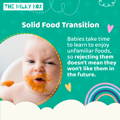
Feeding Schedule for Baby's First Food
As your baby grows, their nutritional needs change, too. During the initial phase, your baby relies heavily on milk for nutrition. However, they consume less milk as they age and gradually shift towards solid food. This transition is known as the complementary phase.
Once your baby completes this phase, it's essential to establish a feeding schedule to ensure that they get the right amount of nutrition. By the time they turn one, their diet should consist of a balanced mix of solids and milk, and a feeding schedule can help them keep track of their meals.
● At 4 to 6 months, your baby should have two meals, each approximately 2 to 4 tablespoons.
● At 7 to 12 months, your baby should have three meals, each approximately the size of your baby's fist.
As children grow and are introduced to different foods, they develop preferences. You'll become adept at predicting their feeding habits.
How to Start Introducing Solid Foods
When you're initially introducing solids, it's best to offer them when both you and your baby are feeling content and relaxed. This will diminish stress on both parts, creating a happy experience for both. It’s good to think of solids as extras at first.
Baby Feeding Needs
Their nutrition should still be mostly from their breast milk or formula, so don’t worry too much if they struggle to finish a tablespoon of food. Getting them the proper utensils is also key. Choose a lightweight, non-toxic spoon that’s easy to clean and handle.
You might want to keep a few close during feedings, as it is very common for babies to toss them to the floor. Having their own spoon will give them a sense of independence.
A pro tip is to pretend to eat with their spoon before giving them food. You can make contented sounds, smack your lips together, and smile to signify satisfaction. Slowly but surely, they will want a taste of that, too.
Using a bib from the start is also important, as it’s common for parents to struggle with bibs if they start putting them on their infants too late. Like most human behaviors, imitation is key.
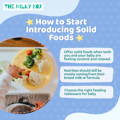
What Foods Should I Introduce to My Child First?
Consider introducing infants to food as if you're opening up a whole new world of flavors, colors, and textures for them to explore. Like with any new journey, introducing new foods slowly is the way to go.
The preparation of the foods will depend on the route you decide to take: purees or baby-led weaning.
Purees follow a more classic approach, with every food carefully cooked and ground down to avoid the introduction of textures. On the other hand, many parents prefer baby-led weaning because it allows infants to experience food on their terms. If you’d like to learn more about it, you should check out our comprehensive guide on baby-led weaning.
With that being said, regardless of their preparation, most recommended foods to begin at six months are similar in both approaches:
● Veggies: Cooked carrot, sweet potato, squash, broccoli, cauliflower, zucchini.
● Fruits: they can enjoy most of them as long as they are ripe enough and the seeds have been taken care of: peaches, banana sticks, kiwi, oranges, strawberries, watermelon, blueberries, raspberries, pitted cherries, and cooked apples.
● Healthy Fats: Avocado, eggs, nut butter (if allergies are absent), real butter, salmon, olive oil, yogurt on a spoon, hummus, and small quantities of goat cheese.
● Cereal: single-grain, iron-enriched, whole-grain variety like brown rice, grain, oat, or whole-grain barley.
Baby's First Foods by Age Food Chart
In the next chart, we will break down the appropriate foods to introduce according to your baby’s age. Most foods are okay from the beginning, while others require more experience and time for your baby’s gastrointestinal system to be ready to digest comfortably.
4 to 6 months: Pureed veggies, fruits, and meats
Cereals fortified with iron are best to replenish their storage and keep those hemoglobin levels healthy. All fruits, veggies, and meats are welcome if they’re appropriately pureed and prepared without added sugar or additives.
You can also add lentils for fiber. The idea is to start with single-ingredient purees to introduce each food to your baby.
6 to 8 months: Single-ingredient finger foods
After the six-month mark, you can experiment with different textures as long as they’re soft enough to be mashed between your fingers. An excellent place to start is small pieces of banana, cooked peas, pieces of peach, boiled pasta, chopped-up hard-boiled eggs, avocado, or rice puffs.
9 to 12 months: Chopped, ground, mashed foods, add flavor
Here is where it gets more fun. They can be introduced to yogurt, cottage cheese, and mashed sweet potatoes. They can also use more iron, so try pureed meats like beef, chicken, and turkey. You can experiment with flavor by adding a drop or two of lemon or herbs.
In this stage, you can skip the blender and mash with a fork instead.
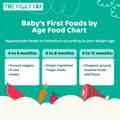
How Should I Prepare Food for My Child to Eat?
It's simpler for your child to consume foods that are mashed, pureed, or strained, with a very smooth texture. It may take some time for your child to become accustomed to new food textures. Once they’re close to being 12 months old, you can start allowing some small chunks in their meals.
You must remove all skin, bones, and fat from poultry, fish, and meats. When it comes to seeds, you should also remove them from all fruits to avoid choking hazards. Spherical foods like grapes, cherries, berries, and tomatoes should be cut into small pieces.
If you opt for a pre-ground cereal, you need to mix it with their regular formula or breast milk to create a smooth consistency. Cow’s or plant-based milk is not recommended at this stage.
As always, avoiding artificial flavorings, such as added sugar and salt, is essential, particularly during the first year. This will give them a better sense of the real taste of foods.
Baby Food Pouches
Baby food pouches are a convenient way for those extra stressful days. They provide enough nutrients for your baby, plus they’re easy to carry and dispose of when you’re out and about.
If you learn how to pick out the nutritious, healthy pouches available on the market, you will have a reliable plan when all else fails. Here are our favorite tips:
- Choose single-ingredient pouches: don’t go for the mixed dinners; these won’t allow your baby to experience each food independently.
- Choose pouches with no added sugar; this one is usually added to fruit pouches labeled as dessert.
- Choose foods without added sugar and sodium on the ingredients list. Ingredients are listed in order of how much of each is by weight. The most significant ingredient is listed first.
A good way to ensure food safety is to feed your baby from a spoon, not the pouch, directly, particularly if you plan to save some of that pouch for later. If their mouth makes contact with the pouch, it can generate bacteria and cause your baby some tummy trouble down the line.
What Are The Signs of a Food Allergy in Babies to Look Out For?
There are a handful of foods that are commonly considered allergens. A couple of decades ago, it was considered to be beneficial for babies to delay their introduction to these foods:
● Peanuts and tree nuts
● Egg
● Cow milk products
● Wheat
● Crustacean shellfish
● Fish
● Soy
Recently, it has been shown that Introducing foods containing allergens early on may lower the risk of your baby developing an allergy. Suppose there are close relatives with food allergies.
In that case, it's advisable to give your child their first taste of highly allergenic foods at home rather than at a restaurant and have an oral antihistamine on hand. If there's no adverse reaction, the food can be gradually introduced in increasing amounts.
It never hurts to stay careful, and the signs you need to look out for are:
● Rashes
● Gassines
● Diarrhea
● Mucus or blood on the stool
● Vomiting
● Mouth swelling
If you notice any of these after introducing a particular food, call your pediatrician to assess your baby’s specific symptoms properly.
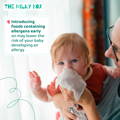
What Solid Foods to Avoid in Your Baby's First Year
There are certain foods to avoid when feeding your baby due to the risk of choking or certain bacterial infections:
● Honey: Avoid for the first twelve months to avoid the risk of botulism
● Raw eggs: Risk of bacterial infection
● Whole nuts, whole grapes, cherries, uncooked raisins, marshmallows, popcorn, chips, big
pieces of cheese or hot dogs: Choking hazard
● Highly processed “baby snacks” Can contain necessary amounts of added sugar.
What about Toddler Formula?
Toddler formula, or growing-up milk, is designed for infants and toddlers transitioning to a balanced diet. When determining whether Toddler Formula is the right choice for your child, it is crucial to consider their unique needs and circumstances.
Toddler Formula is typically recommended for children transitioning from breast milk or infant formula to a balanced whole-food diet. This is because it provides essential nutrients and vitamins that support the child's growth and development during this critical stage.
Moreover, some toddlers may have special dietary requirements or health concerns, making formula a better option than regular cow's milk or plant-based alternatives.
Benefits of Toddler Formula
As toddlers grow, transitioning to solid foods can be a daunting task. Ensuring that they receive all the necessary nutrients for healthy growth and development can be challenging.
Luckily, with European Toddler Formulas, parents can rest assured that even the pickiest eaters will receive the vital nutrients and minerals needed to support their growth.
These formulas are expertly designed to provide balanced and age-appropriate nutrition for toddlers, making it easier for parents to manage their children's diet and ensure they get everything they need to thrive.
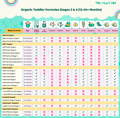
In Conclusion
While it may seem intimidating, introducing solids is an experience that allows you to develop a deeper connection with your baby. It spikes their curiosity, stimulates their senses, and creates challenges for new parents.
A considerable part of this milestone is balance. You need to pace yourself during this process, ensuring their nutrition is intact while moving forward.
Introducing solids is also part of introducing your baby to good eating habits. If you create an environment around a table, with a set time and comfortable environment, you will plant the seeds of a healthy lifestyle.
Don’t forget to check out The Milky Box for all your nutritional needs.
Frequently Asked Questions
How do I prevent choking when introducing solids?
Should I give my baby juice?
The consumption of juice is not necessary for babies. Wait until your baby hits one year old before introducing juice. It's not a must-have for babies and doesn't pack the same punch as whole fruits.
Too much juice could cause weight issues and tummy trouble like diarrhea. Sipping on juice all day can also lead to tooth decay. If you decide to give juice, stick to 100% fruit juice and keep it to just 4 ounces a day for kids between 1-3 years of age.
Can I put cereal mixed into my baby’s bottle?
No. Some parents think this is an excellent strategy to help them consume more calories. However, this is not a good idea because babies must learn to maneuver solid food in their mouth, take spoonfuls, pause between bites, and recognize when they're full. These experiences contribute to developing healthy eating habits in babies.
Do I need to wait sometime before introducing new foods?
Ideally, yes. The American Academy of Pediatrics suggests introducing one food at a time and waiting 3 to 5 days before introducing another new food. This allows you to observe your child's reaction to each new food. This practice is advised for all foods, not just common allergens.
Disclaimer:
Please be aware that this information is based on general trends in babies, and it is not medical advice. Your doctor should be your first source of information and advice when considering any changes to your child’s formula and when choosing your child’s formula. Always consult your pediatrician before making any decisions about your child’s diet or if you notice any changes in your child.
Breastfeeding is the best nutrition for your baby because breast milk provides your child with all the essential nutrients they need for growth and development. Please consult your pediatrician if your child requires supplemental feeding.

Dr. Maria Cerino is a medical doctor and a researcher from Mexico, her works being published in prestigious journals like the American Journal of Human Biology among others. As a medical writer, Dr. Cerino focuses on infant nutrition and healthy neurological development in infants and children. In her free time, she enjoys going on walks, watching indie films, and cooking at home.
Read Next:
Reviewed by Suzanne Renee',
Infant Nutrition Expert

Suzanne Renee' is an accomplished professional with extensive expertise in the area of infant nutrition, dedicated to promoting the health and wellbeing of children. She started this journey as a foster parent.
Suzanne has emerged as a strong proponent of the European baby formula and has become a full-time writer on the subject.
In her free time, she enjoys camping, hiking, and going to church.

